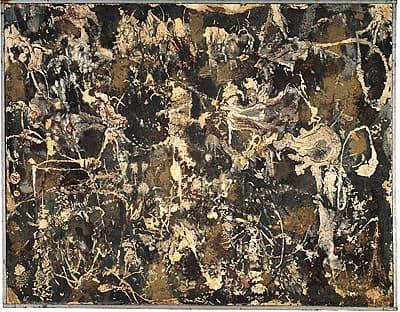
Ralph
BALSON
Great Britain
1890
–
Australia
1964
Australia from 1913;
Great Britain, France, United States of America 1960-61
Matter painting no. 4
1962
enamel and sand in synthetic polymer medium on composition board
signed and dated l.r., synthetic polymer paint "R Balson 62"
107.5 (h)
x 137.5 (w)
cm
Gift of Mr W Balson, the artist's son 1982
National Gallery of Australia, Canberra
NGA 1982.1671
© Ralph Balson Estate.
- with Bill Balson, the artist's son;
- by whom given to the National Gallery of Australia, Canberra, November 1982
- Abstract Expressionism: the National Gallery of Australia celebrates the centenaries of Jackson Pollock and Morris Louis
- 14 Jul 2012 – 24 Feb 2013
- Bruce Adams, Ralph Balson: A retrospective, Canberra: National Gallery of Australia, 1990, cat. 55, illus. col., p. 94;
- Misato Shomura and Atsuko Yamamoto eds., Australian art 1940–1990: From the collection of the National Gallery of Australia: In search of an inner landscape, Gifu: Museum of Fine Arts1995, cat. 61, p. 141, illus. col.
‘Ours is a world of relativity’, said the artist in 1956, ‘a world of ceaseless movement where reality is nothingness and nothingness is reality. Instead of the determinate, the principle of indeterminacy …’.[1]Balson’s approach to painting was inspired by his prolonged study of scientific and mathematical discussions of nature, time and change and, particularly, a fascination with Einstein’s theory of relativity. His tough, late works, such as Matter painting 1960 and Matter painting no. 2 1962, are some of his most evocative, created in a quest to respond to notions of flux and existence.
Balson was one the most progressive Australian artists of his time,[2] who, from the late 1950s sought to explore a spontaneous approach to mark-making and composition. Inspired by the ‘pigment action’ of American Abstract Expressionists, he admired their approaches to paint and painting in that it seemed to offer limitless solutions to ‘pursuing the truly abstract’. In 1960, on his first trip overseas, Balson visited New York, England and France: he found great inspiration in the sensibility of contemporary European tachists Antonio Tàpies and Alberto Burri, and their embrace of chance processes and the raw qualities of materials.
Balson began the series of ‘Matter paintings’, his last major series, while still overseas, working in Devon and Paris in 1960. He poured and dripped paint, celebrating the unpredictable outcomes of combining polymers, enamel, cement and sand. He sought to relinquish aesthetic control as much as possible, allowing chance to govern the outcome of each image. While Balson selected his colours, even then, as James Gleeson noted, he often tried to overcome this ‘element of interference’ by confining himself to tonal selections.[3] Matter painting no.41962, for example, comprises thick layers of enamel and sand in white, brown and rosy-reddish tones. In the process of drying, the surface of the painting has become a landscape of earthy textures, cracks and crevices.
Matter painting1960, on the other hand, possesses the tonal range described by Daniel Thomas as having an ‘outer-space theatricality’, and is one of a number of the few ‘showy’ works this otherwise modest man ever made.[4] It is a vibrant, almost electric, image that encourages the eye to chase lime green, yellow and bright blue marks across the surface. These late paintings have been described as possessing an inner life, as pulsating images and stellar visions of the universe, and Balson as a poet of the universal, shifting flux. Yet, the Matter paintings series also provoked criticism in the 1960s, for what was seen to be a relinquishing of conscious artistic intent through the artist’s reliance on chance.[5] Indeed, he sold only a handful of paintings in his lifetime. Only after his death did Balson’s key role in late modernism and abstraction in Australian art began to be recognised, discussed and celebrated.
Miriam Kelly
[1] Balson in a statement published in John Reed, New Painting 1952–62, Melbourne: Longmans 1963, p. 30.
[2] Alongside Crowley and Frank Hinder, Balson was one of the first Australian painters to devote himself solely to the pursuit of abstraction. In 1941 he held the first solo exhibition in Australia of entirely non-figurative paintings; bold, highly considered, ‘constructive’ images, comprising overlapping geometric coloured forms, in a shallow picture plane.
[3] James Gleeson, ‘Chance work of a genius’, Telegraph, Sydney, 1 June 1969, p.??
[4] Daniel Thomas, ‘Black is beautiful’, Telegraph, Sydney, 25 May 1969, p.??
[5] See for example, Donald Brook ‘Action in the sixties’, Sydney Morning Herald, 25 May 1969, p. ??.
The National Gallery of Australia holds 17 paintings, 74 pastels, a double-sided oil sketch, and a pair of painted clogs by Balson.
